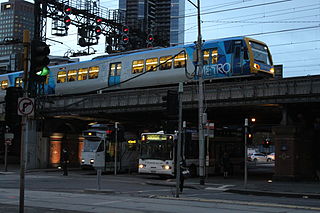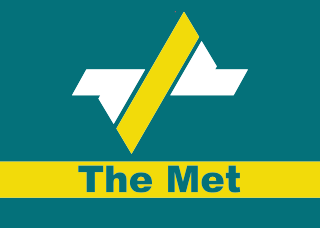Related Research Articles

The City of Melbourne is a local government area in Victoria, Australia, located in the central city area of Melbourne. In 2018 the city has an area of 37 square kilometres (14 sq mi) and had a population of 169,961. The city's motto is "Vires acquirit eundo" which means "She gathers strength as she goes."

Rail transport in Victoria, Australia, is provided by a number of railway operators who operate over the government-owned railway lines. The network consists of 2,357 km of Victorian broad gauge lines, and 1,912 km of standard gauge freight and interstate lines; the latter increasing with gauge conversion of the former. Historically, a few experimental 762 mm gauge lines were built, along with various private logging, mining and industrial railways. The rail network radiates from the state capital, Melbourne, with main interstate links to Sydney and to Adelaide, as well as major lines running to regional centres, upgraded as part of the Regional Fast Rail project.

The Victorian Railways (VR), trading from 1974 as VicRail, was the state-owned operator of most rail transport in the Australian state of Victoria from 1859 to 1983. The first railways in Victoria were private companies, but when these companies failed or defaulted, the Victorian Railways was established to take over their operations. Most of the lines operated by the Victorian Railways were of 5 ft 3 in. However, the railways also operated up to five 2 ft 6 in narrow gauge lines between 1898 and 1962, and a 4 ft 8 1⁄2 instandard gauge line between Albury and Melbourne from 1961.

Transport in Melbourne, the state capital of Victoria, Australia, consists of several interlinking modes. Melbourne is a hub for intercity, intracity and regional travel. Road-based transport accounts for most trips across many parts of the city, facilitated by Australia's largest freeway network. Public transport, including the world's largest tram network, trains and buses, also forms a key part of the transport system. Other dominant modes include walking, cycling and commercial-passenger vehicle services such as taxis. Melbourne is a busy regional transport hub for the statewide passenger rail network, coaches and interstate rail services to New South Wales and South Australia. Freight transport also makes up a significant proportion of trips made on the network from the Port of Melbourne, Melbourne Airport and industrial areas across the city.

The Public Transport Corporation (PTC) was a Government of Victoria owned statutory authority formed under the Transport Act 1983 which operated passenger and freight trains, trams and bus services.

VicTrack, the trading name of Victorian Rail Track Corporation, is a Victorian Government state-owned enterprise which owns all railway and tram lines, associated rail lands and other rail-related infrastructure in the state of Victoria, Australia, with the exception of the Emerald Tourist Railway Board's heritage Puffing Billy Railway.
Port Melbourne was an electoral district of the Victorian Legislative Assembly. It was created in 1889, replacing the previous electorate of Sandridge, which was the former name for Port Melbourne.

The Port Phillip Channel Deepening Project (CDP) began on 8 February 2008 to deepen the shipping channels leading to Melbourne, Australia.

The Port of Melbourne Corporation (PoMC) is a statutory body established by the Victorian Government to develop and manage the Port of Melbourne, Australia's busiest container port. The Corporation commenced operations on 1 July 2003, when it took over the management of the port from the Melbourne Port Corporation. On 1 September 2010, the corporation was re-established with a new charter under the Transport Integration Act.
Transport law is the area of law dealing with transport. The laws can apply very broadly at a transport system level or more narrowly to transport things or activities within that system such as vehicles, things and behaviours. Transport law is generally found in two main areas:

The Transport Integration Act 2010 is a law enacted by the Parliament of the State of Victoria, Australia. The Act is the prime transport statute in Victoria, having replaced major parts of the Transport Act 1983, which was renamed as the Transport Act 1983.

The Department of Transport (DOT) was the government agency responsible for the coordination, integration and regulation of the transport system in the State of Victoria, Australia. The Department generated planning, policy, and legislation for transport in Victoria. As a result, the Department drove the integration of Victoria's transport land and water transport systems and the delivery of public transport, road and port services and associated activities across the State. The Department's stated mission was "Building a safer, fairer and greener transport system for all Victorians to create a more prosperous and connected community."

The Director of Public Transport was the head of the Public Transport Division (PTD) of the Victorian Department of Transport. PTD was the government agency responsible for promoting, providing, coordinating and regulating public transport in the State of Victoria, Australia between August 1999 and April 2012. The Director of Public Transport was created as a statutory office supported by staff of the Department of Transport.
The Chief Investigator, Transport Safety is the independent Government agency responsible for investigation of safety-related trends and incidents in the rail, bus and marine industries in the State of Victoria, Australia.

Public Transport Victoria is the brand name for public transport in the Australian state of Victoria. It was the trading name of the Public Transport Development Authority (PTDA), a now-defunct statutory authority in Victoria, responsible for providing, coordinating and promoting public transport.
The Port of Hastings Development Authority is an authority of the Government of Victoria, Australia. The authority is responsible for the development and management of the port of Hastings located in Western Port Bay approximately 72 kilometres to the south east of Melbourne. The port is expected to be developed by the authority as a major new container port in competition with the Port of Melbourne, Australia's busiest container port.
The Melbourne Harbor Trust was established in 1877 to improve and operate port facilities for the growing city of Melbourne. It was superseded by the Port of Melbourne Authority in 1978 and later by the Port of Melbourne Corporation.
The Department of Economic Development, Jobs, Transport and Resources (DEDJTR) is a former department of the Government of Victoria. It was created on 1 January 2015 by the government of Premier Daniel Andrews when the number of government departments was reduced from 9 to 7, and assumed responsibility for ministerial portfolios previously spread across 5 departments. It was abolished at the end of 2018 and divided into two new departments.

The Victorian Regional Channels Authority (VRCA) is the channel management authority of the Victorian Government for the Port of Geelong, the Port of Portland, the Port of Hastings, and 13 other regional ports.